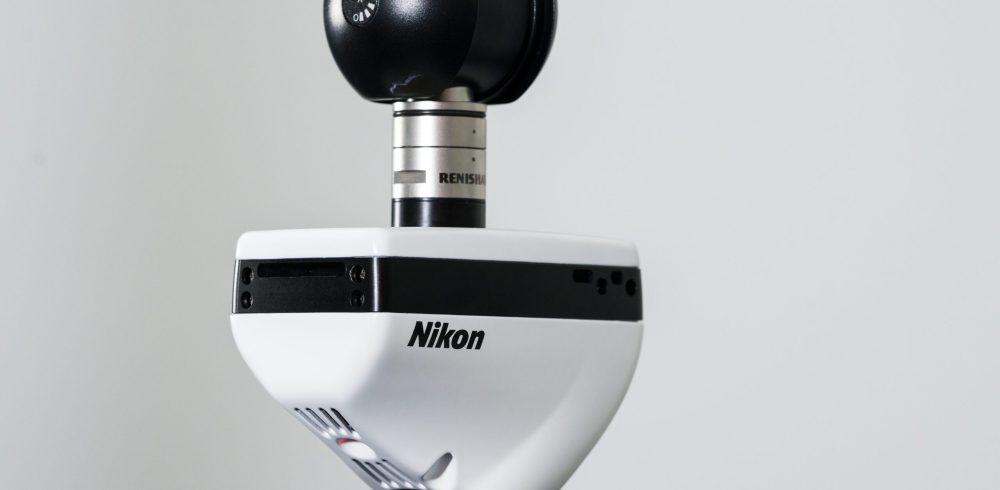For more than a decade, the LC15Dx laser scanner manufactured by the Industrial Metrology Business Unit of Nikon Corporation (https://industry.nikon.com) has been a global benchmark for efficient measurement and inspection of manufactured components, especially those having complex freeform geometry such as turbine blades, orthopaedic implants and intricate plastic parts. Compatible for use with all industry-leading metrology platforms and software, a new version of the sensor has been launched with functionality that has been significantly uprated in several key areas.
The LC15Dx is certified according to ISO 10360-8, the industry standard for the performance of CMM laser scanning devices.  The “ISO 10360‐8 Probing size error All” on the new device is one-third better than previously, 10 rather than 15 microns, so the scanner is able to deliver more accurate and repeatable dimensional measurements, very close to those achievable using a tactile probe.
The “ISO 10360‐8 Probing size error All” on the new device is one-third better than previously, 10 rather than 15 microns, so the scanner is able to deliver more accurate and repeatable dimensional measurements, very close to those achievable using a tactile probe.
Manufactured in-house using glass produced within the group, the Nikon lens is of very high quality. Improvements have been made to the way in which data captured by the lens and imager is converted into measured data points, improving structural resolution to allow even finer surface texture and detail to be seen. The lens is custom-designed for this laser scanning application, enhancing resolution by avoiding having to incorporate an off-the-shelf, third-party lens that merely approximates the ideal specification.
The LC15Dx has always incorporated a patented Nikon software algorithm that maintains scanning accuracy, speed and data quality by automatically adapting the laser settings in real time at each measured point to match the type and reflectivity of the material being examined.  Coupled with a high grade daylight filter to accommodate different ambient light conditions, it enables the inspection of any material, irrespective of its colour, shininess or transparency, without the need for spraying or other surface preparation. This ability has been improved further in the new unit by facilitating better data acquisition from very dark materials. There is even a high ISO mode that can be switched on for coping with black surfaces, including those having a gloss finish.
Coupled with a high grade daylight filter to accommodate different ambient light conditions, it enables the inspection of any material, irrespective of its colour, shininess or transparency, without the need for spraying or other surface preparation. This ability has been improved further in the new unit by facilitating better data acquisition from very dark materials. There is even a high ISO mode that can be switched on for coping with black surfaces, including those having a gloss finish.
The instrument can start scanning more quickly than before after being switched on, raising productivity when inspecting or reverse engineering components. It continues to have zero warm-up time, as an algorithm compensates for any measurements taken while the sensor’s temperature is rising to match that of its environment. New, however, is a halving of boot time to 14 seconds, so the internal computer is ready to receive data much faster. This upgrade promotes metrology productivity by allowing almost instant operation.
Product manager Kristof Peeters said, “Alongside all these improvements is a change of livery to a smart black-and-white appearance, so a user can immediately see they are using the latest sensor version. LC15Dx retrofit kits are available for controllers fitted to all leading makes of coordinate measuring machine (CMM), while a rich array of programming and reporting options is offered by many well-known software providers.”
As with all laser scanners, the new unit is able to provide a huge amount of point cloud data in a very short time for comprehensive insight into what is under investigation, whether it is a prototype or a production component or assembly. The wealth of information enables colour-coded, 3D CAD-to-part mapping for rapid understanding of process variations.
Laser scanning is a non-contact inspection tool, so there is no risk of deforming flexible items like foam or rubber, or of damaging delicate samples. Operation may be combined with tactile probing for multi-sensor measuring routines on a CMM, with automation options using a change rack, allowing deep bores or other difficult-to-see internal features to be accessed by a touch-trigger probe.
Mr Peeters concluded, “The increased resolution and accuracy of data acquisition with our latest LC15Dx laser scanner make it even more suitable for Quality 4.0 inspection applications. Continuous feedback of metrology information to a production line can ensure product conformance by preventing parameters drifting out of tolerance, avoiding the expense of scrapped parts, rework and product recalls.”
Email: leonie.hofmann@nikon.com
Web: www.industry.nikon.com
Manufacturing & Engineering Magazine | The Home of Manufacturing Industry News















